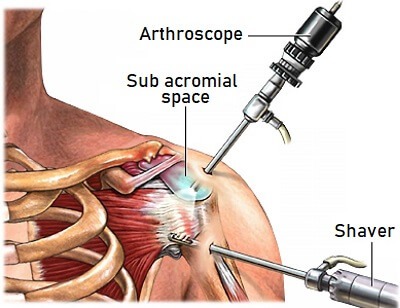
- By shoulderadm
- In Blog
Arthroscopic Subacromial Decompression – A Comprehensive Guide
Subacromial decompression is a type of surgery on the shoulder, which is performed for treating a condition known as shoulder impingement – in which you experience pain when you try to lift their arm. This condition is treated by arthroscopy.
This procedure is done as a stand-alone procedure only if the condition doesn’t respond to conservative treatment – steroid injection and physiotherapy.
 People engage in activities that require them to frequently lift the arms above their heads are more likely to be affected by shoulder impingement.
People engage in activities that require them to frequently lift the arms above their heads are more likely to be affected by shoulder impingement.
What Is Shoulder Impingement?
Shoulder impingement occurs when the tendons in the narrow space between the top of the arm bone and top of shoulder blade becomes damaged. These may happen due to any of the following reasons:
- Swollen tendons are due to wear and tear.
- The improper shape of the bone that rubs against the tendons.
- Growth of small bony structure in and around the tendons.
What Happens During Arthroscopic Subacromial Decompression?
Subacromial decompression is most often performed as a keyhole procedure, by using a narrow, flexible, tube-like camera called an arthroscope. You will be administered with general anesthesia during the procedure, which means that you will be asleep during the surgery. In certain cases, local anesthesia may also be administered in and around the shoulder areas to reduce any pain that may occur after the surgery.
Using the arthroscope, the surgeon identifies the problem areas through small cuts in the skin. This gives the surgeon a better view inside the shoulder.
After the examined, the arthroscope is removed and positioned above the rotator cuff. Here, the bone growth or swelling which is causing the impingement is smoothened using surgical instruments that have been specially designed to carry out the subacromial decompression procedure. Once the decompression is done, the instruments are removed, and the incisions and cuts are now sealed with stitches.
If the pain is severe, this procedure is extended to repair the other damaged tendons in and around the shoulder as well. In such cases, the cut on the shoulder will be larger, and instead of keyhole surgery, it becomes an open surgery. However, this depends on the severity of the pain and affected tendons.
Post-Surgery Care
After the surgery, full recovery may take up to two to four months. In the initial few weeks, you may require help in washing, dressing, and other such activities.
You are advised to visit a physiotherapist after the operation, who will recommend exercises for a smooth recovery. These exercises are important as some people are prone to develop stiffness in the shoulder, known as frozen shoulder, after the surgery. With physiotherapy, the frozen shoulder is substantially reduced and aids the movement of the shoulder.
It is important to discuss the entire procedure with the surgeon before the surgery, and any pain that may occur after the surgery. Also, make sure that you have someone to assist you immediately after the surgery, and at least for the first few days. Avoid lifting heavy weights or doing strenuous exercises.
Discuss your medical conditions with the Shoulder Surgeon beforehand, and about any complications that may occur.
For enquiries and online appointments, send a message to www.BangaloreShoulderInstitute.com/contact






